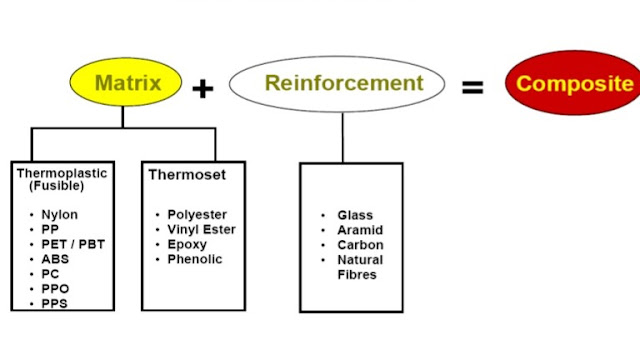Composite Materials:
- Made from two or more constituent materials
- Materials having significantly different physical or chemical properties
- Produced material has different characteristics from the individual components
Classification Of Composites based on Matrices
What are Composites?
Why
Composites ?
- A composite is a mixture of two or more phases (materials)
- A better or unique combination of properties is realized when different materials (or phases) are combined
- The primary needs for all the advanced composites are:
- Light weight, higher operating temperatures, greater stiffness, higher reliability and affordability
What makes a material a Composite?
- Composite materials are formed by combining two or more materials that have quite different properties.
- The different materials work together to give the composite unique properties, but within a composite you can easily tell the different materials apart – they do not dissolve or blend into each other
- Composites can be produced using three classes of materials: Polymers, Metals & Ceramics ( Also natural composites are made from wood, bamboo,shells, bones, other tissues & Natural Fibres like cotton, jute, wool etc.)
Making
a Composite:
Most
composites are made up of just two materials. One material (the Matrix or
Binder) surrounds and binds together a cluster of fibres or fragments of a much
stronger material (the reinforcement)
Examples:
1) In case of
mud bricks, the two roles are taken by the mud and the straw; in concrete, by
the cement and the aggregate; in a piece of wood, by the cellulose and the
lignin.
2) In
fibreglass, the reinforcement is provided by the fine threads or fibres of
glass, often woven into a sort of cloth , and the matrix is a plastic.
Two phase
composite:
- Matric is the continuous phase and surrounds the reinforcements
- Reinforcement is the dispersed phase, which normally bears the majority of stress
What is Matrix in composite?
- Matrix is made from Metal, Polymer or Ceramic
- It is in Continuous phase
- Some ductility is desirable
- Binds the reinforcements (fibres/particulates) together
- Mechanically supporting the reinforcements
- Load transfer to the reinforcements
- Protect the reinforcements from surface damage due to abrasion or chemical attacks
- High bonding strength between fibre and matrix is important
What
is Reinforcements in composite?
- A reinforcement is the strong, stiff integral component which is incorporated into the matrix to achieve desired properties
- The term ‘reinforcement’ implies some property enhancement
- Different types of reinforcements:
- Fibres or filament: Continuous fibres, discontinuous fibres, whiskers
- Particulates reinforcement may be of any shape, ranging from irregular to spherical, plate- like or needle-like nanoparticles
- They have a low ductility
Polymer
A large
molecule (macro-molecule) composed of repeating structural units (monomer)
typically connected by covalent chemical bonds
Glass Fibre plays an Important role in Composites (in glass composites)
Polymer
Matrix Composite (PMC):
- Consisting of a Polymer (resin) Matrix and Fibre
- Very popular due to their low cost and simple fabrication
Applications of PMCs
Fibres
in PMCs
Various
forms:
- Discontinuous (chopped)
- Continuous or woven as a fabric
Fibre
used:
- Principal fibre materials in FRPs are Glass, Carbon & Kevlar 49.
- Less common fibres include Boron, SiC, Al2O3 and steel.;
- Glass is the most common fibre material in today’s FRPs; It’s use to reinforce plastics dates from around 1920
Polymer
Processing:
Forming
Processes for Thermosetting Matrix
Composites:
- Pultrusion
- ResinTransfer Molding
- Hand Layup and Spray up techniques
- Filament Winding
- Autoclave Molding
Forming
Processes for Thermoplastic Matrix
Composites:
- InjectionMolding
- DiaphragmForming
- Film stacking
- Thermoplastic tape laying



Post a Comment